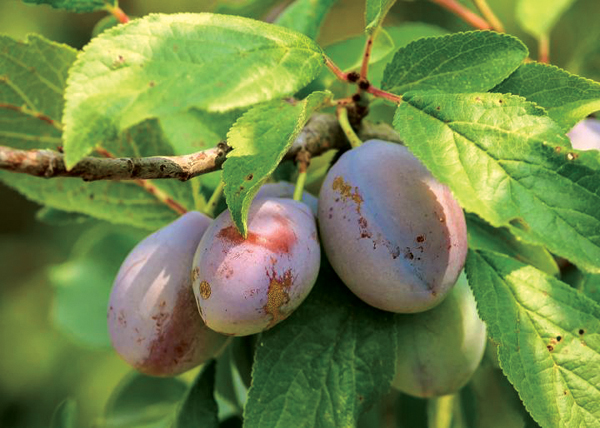Planting, growing, and harvesting plums
Published 12:44 pm Friday, August 28, 2020

- Plums are great for making jams or jellies and can be stored through freezing or drying them.
|
Getting your Trinity Audio player ready...
|
By OLD FARMERS ALMANAC
Ever thought about growing plums? If grown in the right spot, plums can be prolific producers and add beauty to your backyard. Plus, plums are delicious cooked in jams and cakes or eaten right out of hand! Here’s how to plant, grow, and harvest plums!
CHOOSING A PLUM TREE
It’s important to choose a type of plum that will work with your location. There are three major categories of plum trees: European, Japanese, and American hybrids.
The hardy European types do well in most regions across the U.S., whereas the Japanese types flourish where peach trees thrive (warmer regions, generally). The Japanese plums’ early blooms make them more susceptible to spring frosts in colder areas. American hybrids are typically the hardiest of the plums, with some varieties being able to survive as far north as Zone 3.
European plums are generally self-fertile, but Japanese and American hybrid plums usually need to cross-pollinate with a second variety for cross-pollination. So, if you have space for only one tree, go with a European plum. However, even self-fertile trees will produce better if cross-pollinated with a second tree.
Order bare-root, rather than container-grown trees, if possible. Bare-root plants usually establish better. A well-established tree will yield up to 2 bushels of plums from late summer into fall.
WHEN TO PLANT PLUM TREES
Plant plum trees in late winter or early spring while the trees are dormant.
SELECTING A PLANTING SITE
Plums should really only be planted in a prime location featuring all of the following characteristics. Otherwise, they may not perform well.
Plant plum trees in loamy, well-drained soil. Plums do not do well when planted in clay-heavy soils or in locations where their roots will be constantly wet.
Choose a planting location that receives full sun — 6 to 8 hours of direct sunlight at the very least.
Avoid planting in low areas where frost may settle, as the frost can damage your trees. Because they flower so early, plums are especially vulnerable to spring frosts, which can damage blooms and result in sub-par fruiting.
If possible, find a sheltered location, such as a south- or west-facing spot out of the wind. This will help the plum tree set fruit.
HOW TO PLANT A PLUM TREE
Space standard-size trees 20 to 25 feet apart and dwarf trees 10 to 15 feet apart.
Set bare-root trees atop a small mound of soil in the center of the planting hole, and spread the roots down and away without unduly bending them.
To prepare a container-grown tree for planting, remove the tree from its pot and get rid of any tightly circling roots by laying the root ball on its side and using shears to trim off these roots. Do your best to untangle roots without damaging roots, but if the root ball is particularly pot-bound, you can loosen it by scraping up and down the sides with a knife or hand fork.
When planting grafted trees, it’s important to keep the graft union 1 to 2 inches above the soil line. This is especially true for dwarf varieties, as roots may start to grow from above the graft if the tree is planted too deep, bypassing the rootstock that keeps the tree dwarf-size.
Dig a hole that’s a few inches deeper and wider than the spread of the roots.
For bare-root trees, set the tree on top of a small mound of soil in the middle of the hole and spread the roots away from the trunk without excessively bending them.
For container-grown trees, simply place the root ball in the middle of the hole.
Fill in the hole, stopping periodically to make sure that the roots are thoroughly covered and no air pockets remain around the tree.
Water the tree thoroughly at the time of planting; this helps the soil to settle around the roots. Keep the tree well watered for the first few weeks after planting.
For bare-root trees, it’s often recommended to stake the tree for at least one year, until the tree is stable enough to stand on its own.
CARING FOR PLUM TREES
Be sure to water the young trees heavily every week during the first growing season to help promote growth. Then, water regularly. It’s best to water the plant deeply at the soil line, then let the soil dry out (though not completely) and water again.
If rain is lacking, water your tree well into mid-October to give it plenty of moisture through the winter months.
Do not fertilize young fruit trees until they have set a crop.
Once established, fruit production requires regular fertilizing all year long. If there’s good fruit set, fertilize with one pound calcium nitrate per tree or 1½ lb. 10-10-10. Cut back the nitrogen in fall and winter to avoid encouraging new growth in those seasons.
WHEN TO HARVEST PLUMS
Plums are ready to be harvested from late summer into fall, depending on your area.
European plums have the best flavor when left to ripen on the tree. You can tell when plums are ripe by applying gentle pressure with your fingers. If the skin of the fruit feels soft, then it is ready to be picked. Plums should come off the tree easily with just a slight twist of the fruit.
Japanese plums are picked slightly earlier; allow them to ripen in a cool place.
Plums will not sweeten much after harvest, so be sure to pick them when they’re mature. (Try one before you pick them all!)
Unfortunately, the fruit does not store for long, so must be eaten or preserved. Alternatively, you can pick the fruits when they are still slightly firm and store them in a cool place to fully ripen.
The best place to store plums is in the refrigerator. The best temperature for storing plums is about 31° to 32°F with relative humidity around 90–95%; if kept at this temperature, plums may last for 2 to 4 weeks.


